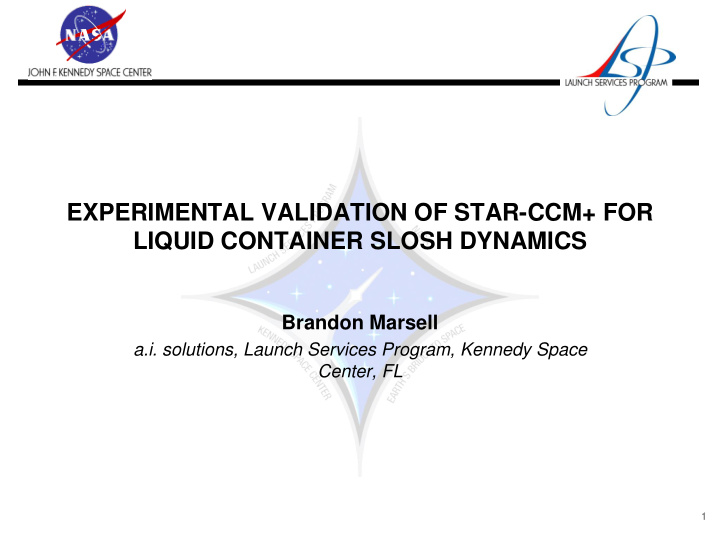



EXPERIMENTAL VALIDATION OF STAR-CCM+ FOR LIQUID CONTAINER SLOSH DYNAMICS Brandon Marsell a.i. solutions, Launch Services Program, Kennedy Space Center, FL 1 1
Agenda • Introduction • Problem • Background • Experiment • STAR-CCM+ CFD model • Results • Conclusion 2 2
Introduction • Launch Services Program – Provide leadership, expertise and cost effective services in the commercial arena to satisfy agency wide (NASA) space transportation requirements and maximize the opportunity for mission success – Interface between launch service provider (commercial) and NASA spacecraft – Requires engineering success • Mission Analysis Division – Verify and validate mission engineering/analysis – Conduct any analysis required by NASA’s unique missions – Reduce technical risk to NASA missions 3 3
Problem • Fuel Slosh – Liquid propellants account for most of the mass on a launch vehicle – During flight, these liquids “slosh” back and forth within the tanks – This sloshing motion causes forces on the vehicle which must be accounted for in the flight software – Both frequency and damping rate for all liquid propellant tanks must be accurately predicted in order to create an efficient autopilot design – The idea is to keep the rocket flying straight! » This will lead to engineering success • Typical propellant tanks on NASA missions – 2 on booster stage – 2 on upper stage – 1-16 tanks on payload 4 4
Background • Guidance Navigation and Controls (GN&C) analyses use simplified mechanical analog models – Spring mass system – Pendulum system • These simplified models require parameters as inputs – Pendulum mass – Fixed mass – Pendulum length – Hinge point – Fixed mass location • These parameters vary as a function of fill level 5 5
Background • How to derive these parameters – Experimental data » Expensive » Time consuming » Lots of data reduction necessary – CFD » Quick » Inexpensive » Simple – Analytical Methods » Very easy to apply » Only valid with simple geometry • CFD must first be validated – Producing engineering success 6 6
Experiment • Carried out at Embry-Riddle Aeronautical University • Simplified case – 8 inch diameter sphere – Water – 60% fill level – Linear excitation – Step impulse and hold – No breaking waves 7 7
STAR-CCM+ Model • Same geometry was modeled using STAR-CCM+ – Volume of Fluid (VOF) » Phase 1 = water » Phase 2 = air – Implicit unsteady » 2 nd order Time » Timestep 0.0025 s » Total time 20 s – Gravity » 1g – Constant density (incompressible) » 997.561 kg/m^3 – water » 1.18415 kg/m^3 - air – Three dimensional 8 8
STAR-CCM+ Model • Mesh – Used simple (new shape part) sphere – Surface remesher – Trimmer Mesh » Works well with VOF formulation » Need high resolution throughout domain – Prism layer mesher for accurate viscous damping – 3.1 M cells • Boundary Condition – 1 region » Walls » No-slip 9 9
STAR-CCM+ Model • Stopping Criteria – Maximum inner iterations = 10 » Reduced residual by at least 2 orders of magnitude – Maximum physical time = 20 s – Maximum steps disabled • Reports/monitors/plots – Fluid forces on tank walls STAR-CCM+ Results » Pressure and viscous » X, Y, Z direction » Plot every time step • Initial condition – Fluid velocity = 0.065 m/s 10 10
Results STAR-CCM+ Results Comparison STAR-CCM+ 11 11
Results Frequency 2.148 3.784 2.026 3.589 12 12
Results Frequency • difference roughly 5% • Very sensitive to fill level – Experiment was filled using fluid volume – CFD initialized using fill level converted from volume – Frequency content in “stinger”? 13 13
Damping Ratio • Logarithmic decrement Δ – Δ =ln(peak oscillation / peak one cycle later) • Damping ratio γ – γ = Δ /2 π – 2.9% difference – Very difficult to calculate properly Damping Ratio Experiment 0.004002 STAR-CCM+ 0.003887 14 14
Conclusion • STAR-CCM+ validated for low amplitude, simple geometry slosh modeling • Both frequency and damping rate match fairly well – Frequency off a bit more than desired but that could be caused by inaccurate fill procedures during experimental testing – Further research will be carried out to investigate the causes • Increases LSP confidence in this method for slosh calculations • Will add to LSP’s engineering success! 15 15
Recommend
More recommend